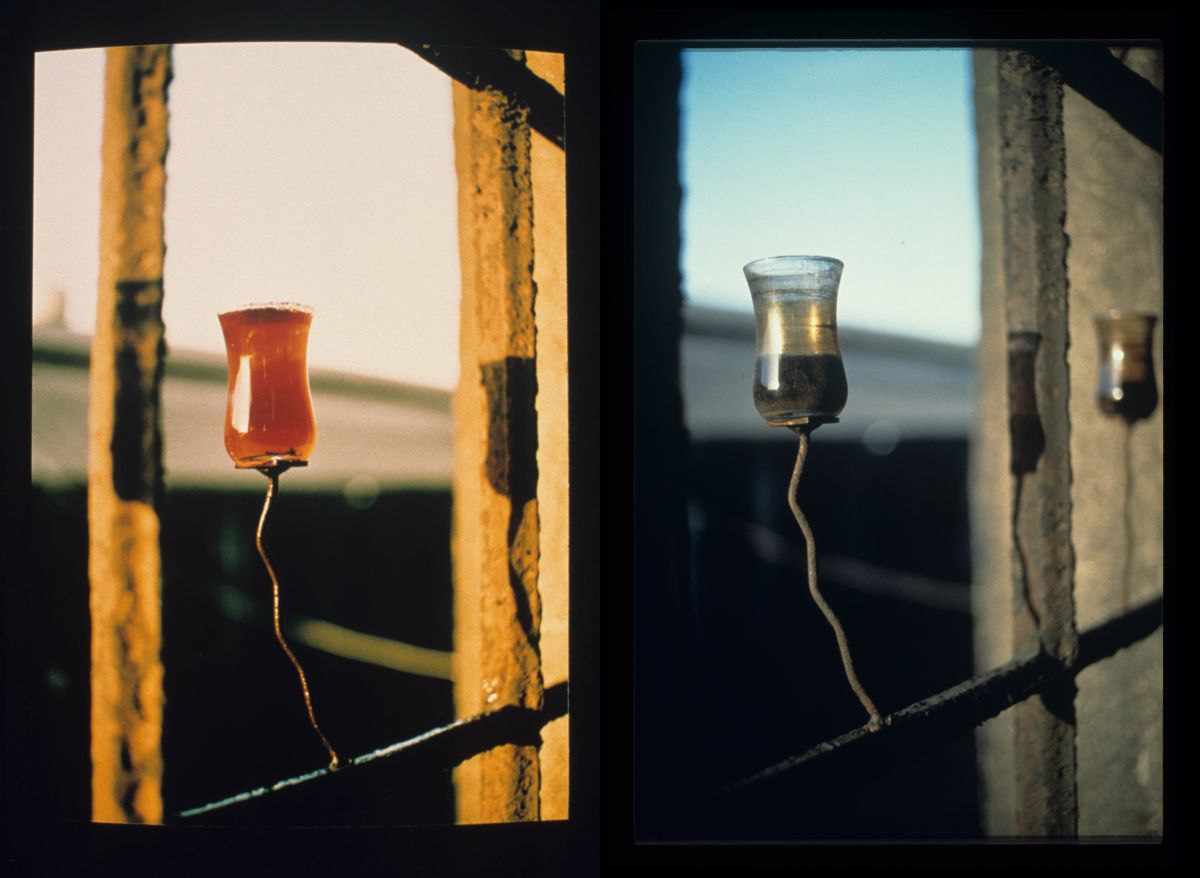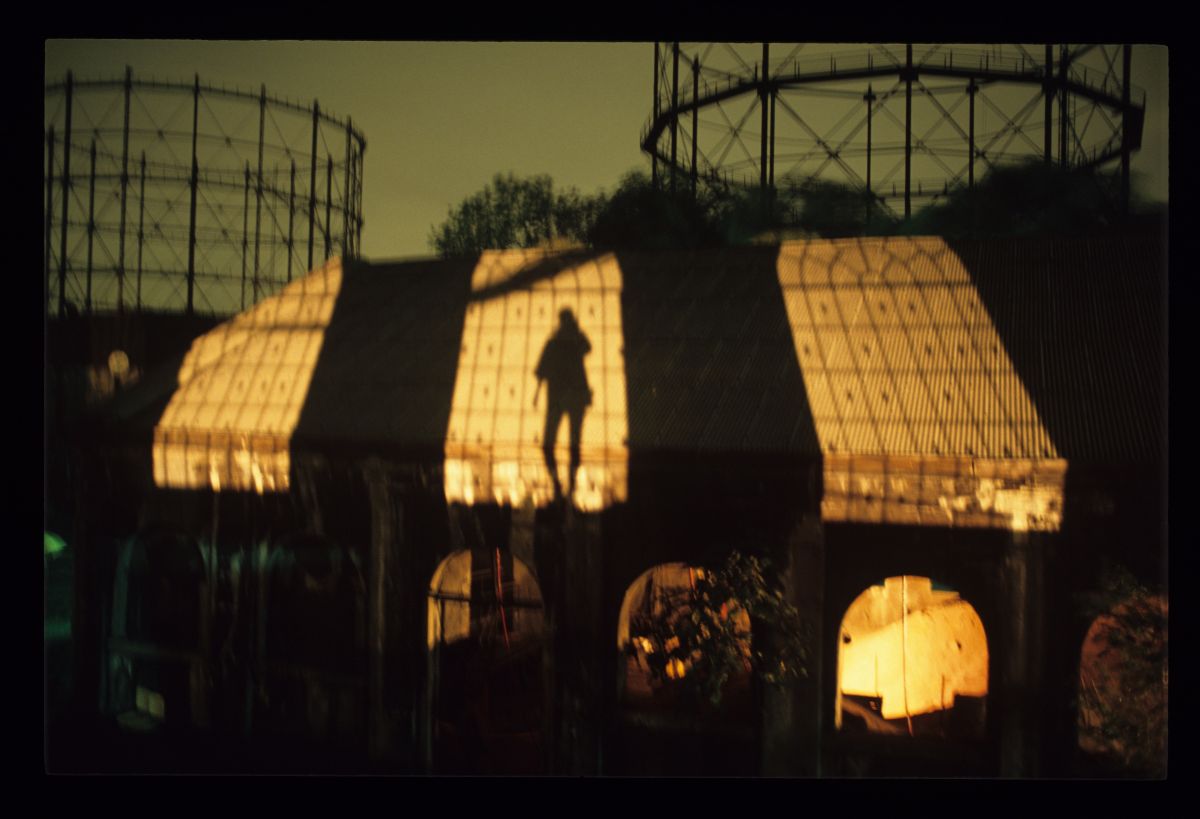On "Tea and Coal"
Eliza Proctor
December 6, 2022

Details from Eliza Proctor’s Çay ve Kömür [Tea and Coal], Seretonin II (1992), Yedikule Gasworks, Istanbul
Courtesy the artist
Courtesy the artist
*Eliza Proctor was among the participants of the exhibition Seretonin II (1992) held in Istanbul’s Yedikule Gasworks. The following piece by Proctor was written in October 2022 as a tribute to the collective spirit of the event, and published as part of Salt’s The 90s Onstage exhibition.
Creating Çay ve Kömür [Tea and Coal] for Seretonin II was an immersive experience. I dove right in on the invitation… I recall Vasıf [Kortun] introduced me to Arhan [Kayar]. Both were so welcoming! Once we walked through the gate of the Gazhane and while meeting some of the workmen, I remember being completely stunned by the black-on-gray environment. Everything was just covered in coal dust. I just started exploring, I went back again and again. I worked on many ideas and experimented with different materials. The workmen were tolerant of me, I mean… I was climbing all over, up on the top of the holding tanks, the cooling tower, everywhere. I ate lunch with them, I played nine rocks with them, drank tea with them. What I found was this incredible determination by the workmen to create a life-affirming environment with green gardens in nooks and crannies. They had a beautiful enclosed green vine tea garden, they even were growing brilliant red peppers on the top of the water-cooling tower! This juxtaposition of color was startling and wonderful.

The Gazhane was feeding the city with gas made from burning coal and these men worked 24/7 in three shifts. I wanted to reflect the pride they showed for their work & workplace by incorporating their daily sustenance—glasses of tea—while also reflecting the damaging effects the work could have on their health.
I chose the five windows in the main furnace building, because the windows had no glass and were only framework. When the building was built, according to the workmen, the beautiful arched windows had glass, but in the very first firing of the furnaces, the smoke overwhelmed the entire interior and the director instructed the men to break out all the glass to allow for the smoke to escape. They never replaced the glass.
The construction of the installation was formed, aside from the glasses, by utilizing scrap materials that I found on site. When I needed a way to chop the sheet metal and rusted fencing wire I had found, they sent me over to the neighboring Railway Repair Yard where I was able to work with their large sheet metal cutter. Also, even though I was plenty experienced, one workman insisted on doing the welding for me as a gesture of support for the project.
Opening night, tea was brewed and I climbed up and poured the tea. In daylight, backed by the sky, it was a constellation of brilliant color. 103 glasses of tea for 103 workmen. Within three days, after multiple firings of the furnaces, the tea in all the glasses of the installation had gone dark with coal dust… After a week they started to evaporate and became more and more densely dark. By the time the exhibition was closed, the tea was sludge.

Not long after the exhibition opened some workmen came to me and said: “We can see. We understand.” They asked to join the exhibition with their own “artwork,” they would file a petition for more comprehensive health benefits from the city.
Creating Çay ve Kömür [Tea and Coal] for Seretonin II was an immersive experience. I dove right in on the invitation… I recall Vasıf [Kortun] introduced me to Arhan [Kayar]. Both were so welcoming! Once we walked through the gate of the Gazhane and while meeting some of the workmen, I remember being completely stunned by the black-on-gray environment. Everything was just covered in coal dust. I just started exploring, I went back again and again. I worked on many ideas and experimented with different materials. The workmen were tolerant of me, I mean… I was climbing all over, up on the top of the holding tanks, the cooling tower, everywhere. I ate lunch with them, I played nine rocks with them, drank tea with them. What I found was this incredible determination by the workmen to create a life-affirming environment with green gardens in nooks and crannies. They had a beautiful enclosed green vine tea garden, they even were growing brilliant red peppers on the top of the water-cooling tower! This juxtaposition of color was startling and wonderful.

Eliza Proctor playing nine rocks with the gashouse workers
Courtesy the artist
Courtesy the artist
The Gazhane was feeding the city with gas made from burning coal and these men worked 24/7 in three shifts. I wanted to reflect the pride they showed for their work & workplace by incorporating their daily sustenance—glasses of tea—while also reflecting the damaging effects the work could have on their health.
I chose the five windows in the main furnace building, because the windows had no glass and were only framework. When the building was built, according to the workmen, the beautiful arched windows had glass, but in the very first firing of the furnaces, the smoke overwhelmed the entire interior and the director instructed the men to break out all the glass to allow for the smoke to escape. They never replaced the glass.
The construction of the installation was formed, aside from the glasses, by utilizing scrap materials that I found on site. When I needed a way to chop the sheet metal and rusted fencing wire I had found, they sent me over to the neighboring Railway Repair Yard where I was able to work with their large sheet metal cutter. Also, even though I was plenty experienced, one workman insisted on doing the welding for me as a gesture of support for the project.
Opening night, tea was brewed and I climbed up and poured the tea. In daylight, backed by the sky, it was a constellation of brilliant color. 103 glasses of tea for 103 workmen. Within three days, after multiple firings of the furnaces, the tea in all the glasses of the installation had gone dark with coal dust… After a week they started to evaporate and became more and more densely dark. By the time the exhibition was closed, the tea was sludge.

Eliza Proctor, view from the opening night of Seretonin II (1992), Yedikule Gasworks, Istanbul
Courtesy the artist
Courtesy the artist
Not long after the exhibition opened some workmen came to me and said: “We can see. We understand.” They asked to join the exhibition with their own “artwork,” they would file a petition for more comprehensive health benefits from the city.

